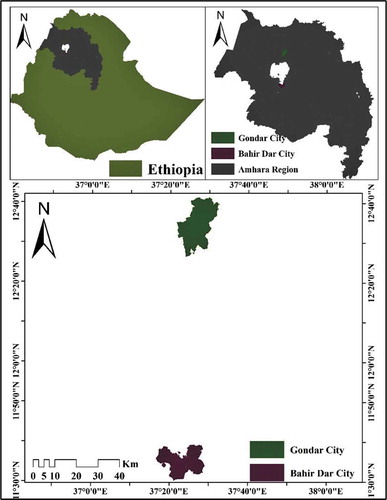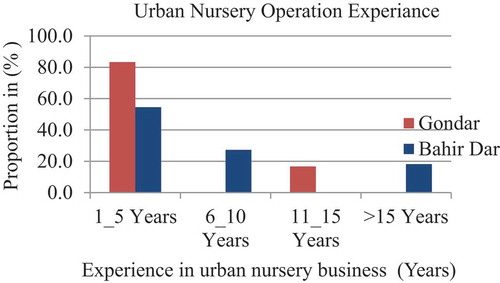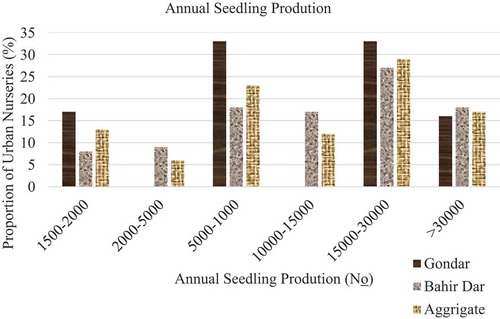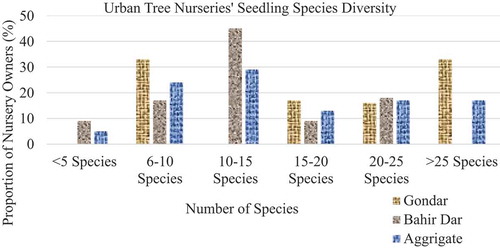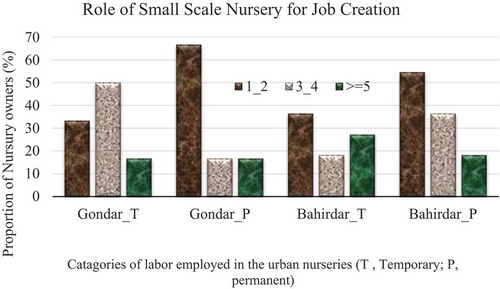 ?Mathematical formulae have been encoded as MathML and are displayed in this HTML version using MathJax in order to improve their display. Uncheck the box to turn MathJax off. This feature requires Javascript. Click on a formula to zoom.
?Mathematical formulae have been encoded as MathML and are displayed in this HTML version using MathJax in order to improve their display. Uncheck the box to turn MathJax off. This feature requires Javascript. Click on a formula to zoom.Abstract
There is a growing interest to understand and establishment of urban tree nursery in Ethiopia and the horn of Africa. Socioeconomic contributions of urban tree nurseries, which are vital economic activities in major cities of Ethiopia in general and particularly in Bahirdar and Gondar cities are not adequately studied and well documented. Therefore, this study aims to evaluate socioeconomic contribution of urban small-scale tree nurseries and to evaluate the financial profitability of small-scale tree nurseries. Both qualitative and quantitative data were from primary and secondary source using urban tree nursery owner’s survey, key informant interview and focused group discussion Qualitative data was analyzed descriptively, while financial analysis was conducted for quantitative data. The result revealed that urban tree seedling production was established recently government-owned land and handled by both male and female. On average 18920 ± 15990 and 15464 ± 13363 seedlings were produced per annum per individual in Bahir Dar and Gondar cities, respectively. Urban tree seedling producer in Gondar and Bahirdar generates an annual net profit of 338377–810183 ETB birr. Small-scale nurseries maintain the livelihoods of owners while creating permanent job opportunity to 1–2 jobless individuals per nursery site in both study cities. Generally, the result confirms urban nursery seedling production was profitable and potential business enterprise in the cities. The finding of the research is expected to contribute for the development of nursery expansion to the nursery owner. However, shortage of land for establishments of the nursery is constraining seedling production in the study areas. Therefore, actions such setting set land, during town planning is recommended to engage new entrepreneurs are some of the actions to be taken to strengthen the sector’s development.
PUBLIC INTEREST STATEMENT
Urban small-scale nursery production plays a great role for job creation and poverty reduction in addition to its ecological and aesthetic values. Currently, unemployment is becoming one of the serious problem in the world and Ethiopia. Therefore, research findings in small-scale urban nursery production are highly important for government and non-government organizations for creating business and other investments. The finding of evaluation of financial profitability and the socio-economic importance of urban small-scale tree nurseries would contribute for other entrepreneurs to invest in urban nursery production, for national urban greening programs and other developed and developing cities and call for the respective institutions for supporting nursery owners. Generally, the finding of this research provides relevant information for development practitioners interested in nursery production. It can also serve as baseline study for researchers, organizations and students who are interested in further studying urban nursery, urban greening area management and other related subjects. And also will promote for better production system.
Competing Interests
The authors declare no competing interests.
1. Introduction
The rate of urbanization in developing world is fast attributed to rural–urban migration, economic growth and development, technological change, and rapid population growth (Marshall et al., Citation2009). Ethiopia is one of the developing and the least urbanized countries in the world with only 16% of its population living in urban centers (PCC, Citation2008). However, given the 2.73% total annual population growth rate, high rate of in-migration to towns, and increase in the number of urban centers, the rate of urbanization is increasing in Ethiopia at a rate of 4.4% (MoFED, Citation2006). According to UN HABITAT (Citation2007) report, the country’s urban population is expected to grow on average by 3.98% and by 2050; about 42.1% of the total population is expected to be inhabited in urban centers. The cities of Bahirdar and Gondar in northwest Ethiopia, where this study was conducted, are among the fastest-growing urban centers in Ethiopia both demographically and spatially. The amount of land demanded for different urban development and greening purposes is increasing every year. The population of Bahirdar city was 221,991, of whom 108,456 are men and 113,535 women (CSA, Citation2007). Whereas, Gondar city had a total population of 207,044, of whom 98,120 were men and 108,924 women (CSA, Citation2007).
Demographic and economic expansions of cities as a result of migration and industrial development tends to complement their spatial expansion through encroachment of cities upon the adjacent “peri-urban” areas. The triggers of this change are the consequence of socio-economic advancement of the surrounding communities which can gear to urban concentration and growth of large cities (Tassie Wegedie, Citation2018). As a result of expansion of cities and increased number of population, service sectors and urban infrastructures such as road infrastructures and urban greening are becoming equally important for the wellbeing of urban dweller (Frigeri et al., Citation2017). Urban seedling nurseries play a key role in increasing urban green areas and streets (Mukundi & Kariuki, Citation2007). According to Rutto and Odhiambo (Citation2017) and Basweti et al. (Citation2001) urban tree nurseries are seedling production sites which can be established along road sides and road reserves under informal land tenure systems. The expansion of urbanizations increases the need for tree planting both at private, communal and public level, along the roads, hotels, schools and offices. This demand for tree planting increased interests in engagement of small-scale private nursery production by different practitioners in the cities.
According to Rutto and Odhiambo (Citation2017), (Basweti et al., Citation2001), Urban tree nurseries are seedling production sites which can be established along road sides and road reserves under informal land tenure systems.
Many studies have been conducted so far on production system and their socio-economic contribution of private nurseries (Abdulhamid, Citation2016; Babalola, Citation2008; Basweti et al., Citation2001,; Mercado & Duque-Pinon, Citation2008).
However, the socio-economic contribution of urban tree nursery seedling production was not yet well studied and poorly documented particularly in Ethiopia. Few studies were conducted previously in Ethiopia but they were focused on the quality of seedlings (Dedefo et al., Citation2017). Studies showed that the socioeconomic contribution of tree seedling nurseries varies with geographic location, market access and market information, seed source, limited knowledge on nursery operation, poor relationships between nursery owners and various service providers, limited land ownership and production capital, poor production system and poor provision of incentives and policy support (DTVED, Citation2018; GDUAD, Citation2018).
Thus, identify socio-economic benefits of such urban tree nurseries are very important for policy makers and development sectors to understand and make appropriate decision and support to growers. Therefore, this study was initiated and developed to evaluate the socio-economic contribution of small-scale urban seedling nursery enterprises in Gondar and Bahir Dar cities, Northwestern Ethiopia.
2. Methodology
2.1. Description of the study areas
The study was conducted in Gondar and Bahirdar cities of Amhara Regional state, Ethiopia (Figure ). The study cities were selected purposively due to the current expansion and availability of urban tree nurseries and urban greening efforts. They also represent different stages of development and practices of urban tree nurseries. Geographically, Gondar city administration is located at 12°36ʹ00” N and 37°28ʹ00”E. (GDUAD, Citation2018). While Bahirdar city is located at 11°36ʹ53” north latitude and37°21ʹ11” east longitude. Gondar city is the capital city of central Gondar zone, Amhara region. While Bahirdar city is the capital city of Amhara Regional state.
2.2. Sampling technique and sample size
The study site selected was purposively due to the current expansion, availability of urban tree nurseries and urban green efforts. Both of them introduce several small-scale urban tree nursery following increased tree demands.
Reconnaissance survey was undertaken during December, (2018) in the study area before the beginning of data collection, to collect baseline information, to identify sites and number of existing small-scale private urban tree nurseries within the study areas. Reconnaissance survey result revealed that there are 6 nurseries in Gondar and 11 nurseries in Bahirdar. Census was conducted because of small number of population exit in the study area (A total of Seventeen (17) nurseries, 6 from Gondar and 11 nurseries in Bahirdar) were sampled and interviewed.
2.3. Methods of data collection
Both qualitative and quantitative data were collected from relevant primary and secondary sources using a combination of data collection tools including nursery owner’s interview, key informant interview and focus group discussion. A total of 17 nursery owner’s interview, 10 key informants’ interviews and 8 focus group discussion were conducted. Participants of FGD in each study cities were selected from (urban agriculture expert, experienced nursery owners and college of Technic and vocational training). Key informant participants purposively selected from forest sector expert from Office of Urban agriculture and Environmental protection, Urban Agriculture support, inspection and development expert from Departments of Technic Vocational and Enterprise development and Industry extension and technology transformation officer from Technical Education and Vocational Training of each cities as they have expected to have knowledge and information on seedling production in the cities. Personal observations were done also to complement data collected through questionnaires and verify some of the information like species grown, type of materials used and price of the seedlings.
To collect data checklists were prepared and interviews were carried out by researchers during January–February, 2019. Follow-up visits were conducted where nursery owners were not available on the first visit, and ultimately all the sampled nursery owners were interviewed.
2.4. Data analysis
The qualitative and quantitative data were analyzed using descriptive statistics and financial analytical procedures such as profitability analysis. Data was transcribed, coded and cleaned and entered into computer software, SPSS (Statistical package for social science) and MS excel for analysis. The data when then presented in texts, tables and figures. Detailed account of the analytical techniques used for profitability is presented in the following.
2.5. Analysis of profitability
The economic variables (profitability and capital turnover) were analyzed by using the three tools of economic analysis namely Gross Income (GI), Net Income (NI) and Rate of Return on Investment (RORI).
Net Income (NI) is defined as the difference between gross income (GI) and Gross cost (GC)
Mathematically:
where NI = Net Income
GI = Total quantity of product sold over the period prevailing market price
GC = Total cost of production (cost of labor, fertilizer, water, polythene bags, seed and compost)
Rate of return on investment (RORI) = The Rate of Return on Investment depicts the level of profitability of an investment and is an important criterion in determining the choice of investment. It is determined using the following relationship:
Where: GI = Gross Income and GC = Gross Cost of production according to Oluskosi and Erhabor (Citation1988) as cited in Tee & Labo, Citation2010).
3. Results and discussion
3.1. Demographic characteristics of nursery owners
As indicated in Table , the survey revealed most of urban tree nursery owners about (82.4%) were owned by males. This might be related to the labor-intensive nature of the business and the requirement of business skill for commercialization of the seedling products. This result is consistent with the findings of (Akintoye et al., Citation2011; Mudyiwa et al., Citation2015) that approves the dominancy of males in urban tree nursery operation as business activities attributed to labor-intensive nature. Interims of marital status most of the nursery owner were married.
Table 1. Demographic characteristics of nursery owners
The result confirms majority of nurseries (about 82.4%) were operated by young age group ranging between 20 and 40 years. This could be associated with the current government initiatives of empowering and organizing the adult and youth and linking them in job creation and self-employment activities and the increased motivations of adults to be engaged in self-employment business activities. Our finding is in line with the works of Rutto and Odhiambo (Citation2017) that designates the dominance of youth participation in urban tree nursery production in Kenya. And the remaining 11.8% were the range between 41–50% and 5.9% were within the age range >51 (Table ). The average age of the nursery owners in Gondar was 35 years (SD = 5.477) while in Bahirdar the average age of the nursery owners was 34.5 years (SD = 9.114) (Table ).
Table 2. Characteristics of Gondar and Bahir Dar nursery between age, family size and experience
The average family size of the urban tree nursery owners was 3.5 (SD = 2.59) and 3.18 (SD = 2.22) in Gondar and Bahirdar, respectively (Table ). The family size of the nursery owners has an implication on the number of household members supported by the income from urban nurseries in one hand and the availability of family labor for the nursery operations in the other hand.
The survey result in Table , signposted that this urban nursery business activity is managed and owned by well-educated personnel. Most of the nursery owners have educational qualifications of diploma and above. This could be related to the enterprunial skill required for running the urban tree nursery business and commercialization of the seedling production. Moreover, this result shows the increased interest of graduates for self-employment rather than waiting job from government. The minimum educational background of nursery owners was primary school level.
3.2. Experience of nursery owner
As presented in Figure , the engagement history of nursery owners in urban nursery as business activity was 2–18 years for Bahirdar. While, it was 1–15 years in Gondar.
The average experience of the nursery owners was higher in Bahirdar (7.09 years, SD = 5.5) as compared to that of Gondar (4.33 years, SD = 5.3). This indicates relatively a recent development of urban nursery business in Gondar city as compared to Bahirdar city.
Generally the result this study reveals the increasing trend of peoples’ engagement in seedling production in urban areas in both cities, although the majority of urban nursery business activity in Gondar (83.3%) and Bahirdar (54.5%) were established recently in (5 years period). The finding indicates that there is the possibility of future development on the participation in this business activity as urbanization and industrialization, which are the potential consumers of urban nursery products are expanding. The result proves that in both areas small-scale private nursery production was becoming as main economic activity in the cities.
3.3. Annual production of seedlings
Individuals from Bahirdar produce higher amount of seedlings in average as compared to individual seedling producers in Gondar city (Table ), this could be due to the variation in the average nursery land size, availability of support and inputs, as well as availability of market besides the capacity of the nursery owners.
Table 3. The mean and Std. Deviation of annual seedling production of urban nurseries
As indicated in Figure , describes that the majority of nursery owners’ (33.3% in Gondar and 27.3% in Bahirdar) produce seedlings ranged between 5000–10,000 and 15,000–30,000 per annum in Gondar and Bahirdar cities, respectively. The combined mean of the two cities production potential indicates that 29.4% of nursery owners produce seedlings of 15,000 to 30,000 seedlings per annum per individual. This indicates that there is efficient utilization of land they produced large amount of seedling within small size of the nursery land.
As depicted in Figure , the number of species produced by the nurseries owners are varied with sites, the result revealed that 33% of the nursery owner produce more than 25 species in Gondar nursery as compared to Bahirdar. Most of the owners of Bahirdar nurseries (45.4%) produce 10–15 number of species. This shows that the number of species in Gondar is larger to that of Bahirdar nurseries. It could be due to Bahirdar nurseries produce the most selective species of seedling in large amount due to large experience of the nursery owners.
As Table indicates, the number of seedling produce in Gondar and Bahirdar there is no significant difference between them. The number of species raised in Bahirdar and Gondar are 13 ± 6 and 21 ± 11, respectively. The main reason for the production of small number of species in Bahirdar as compared to Gondar could be because of concentration of owners on most preferable species as they have long history of nursery running in relation to producers in Gondar.
Table 4. Number of species in Gondar and Bahir Dar
3.4. Commonly raised tree species of seedling in Gondar and Bahirdar nurseries
In Gondar and Bahirdar a total of 50 and 42 species were raised respectively with 38 common species to both areas. From these species, Casuarina equistifolia, Duranta repensvariegata and Ficus benjamina, Azanirachta indica, Callistemon rigidus, Carica papaya, Phoenix reclinata, Pinus patula, Podocarpus falcatus and Spathodea nilotica were the most common and superior species that are raised by more than 67% of producers in Gondar (Table ). While Duranta repensvariegata, Cupressus semperuuirens, Ficus benjamina, Olea Africana, Terminalia brownie, Callistemon rigidus, Grevillea robusta, Jacaranda mimosifolia, Mangifera indica and Thuja are the most common and superior species of Bahirdar (Table ). This could be due to the market demand of the species (highly preferred by the end users), the seed source of the species, fast growth of the species and the market price, easy propagation method of the species especially ornamental seedling species.
Table 5. The most common species of seedling that raised in Gondar nurseries
3.5. Cost of small-scale private tree nursery production
From the study area, the costs that the nursery operators incurred for seedling production includes material costs and labor for nursery activities. Material costs include Polyethylene tubes, seed and seedlings, compost, soil, sand, labor, and water. Material costs were found to differ considerably between nurseries, depending on the type, quantity of materials used.
The total cost of small-scale private nursery productions in Bahirdar and Gondar was 5,541,600 and 1,828,300 ETB, respectively. The cost of land, seed and polyethylene tubes was the highest cost were the nursery owners incurred Table .
Table 6. Total cost of tree nursery owners
3.6. Profitability of small-scale private tree nursery production
From the study area, the costs that nursery owners incurred for seedling production include material and labor costs for nursery activities. Material costs include Polyethylene tubes, seed and seedlings, fertilizer, compost, soil, sand, labor, and water. Material costs were found to differ considerably between nurseries, depending on the type and quantity of materials used.
The profitability of small-scale private tree nursery to the nursery owners is summarized in (Table ). The finding showed that the average total annual gross income and the mean annual profit/net income from sale of seedlings in Bahirdar was higher than that of in Gondar which is about (1,313,965/year) and (643,093/year), and (810,183/year) and (338,377/year) respectively. This is due to the availability of the nursery land area and year of experience they engaged in the business.
Table 7. Average annual profitability of urban tree nursery in Gondar and Bahir Dar
The Rate of Return on the Investment (RORI) indicates both of the cities nursery production was profitable as indicates about 95.7% and 95.58% in Bahirdar and, respectively, with the ranges between (77% and 141.1%) in Gondar and in Bahirdar ranges between (46% and 270.9%). The result different from Larinde and Santus (Citation2014) reported that plant nursery was profitable in which the value of RORI ranges to 355.56–432.54%.
The least RORI (46%) and (77%) was observed in Bahirdar and Gondar nursery owners, respectively. This is due to the price of seedlings within the nursery units. Size of the nursery land, shortages of inputs like water, soil, compost and lack of experience in seedling production. Generally, Bahirdar nurseries had highest RORI 270% this was due to large size of nursery land area and availability of support and inputs.
Generally from the profitability analysis, it can be concluded that small-scale tree nursery business in the study cites was profitable. Moreover, many people in the cities are now engaging in its production and marketing as a profitable agricultural business. This result is similar with (Larinde & Santus, Citation2014; Tee & Labo, Citation2010) reported that, small-scale plant nursery enterprise is profitable.
3.7. Socioeconomic benefits of urban small-scale private tree nurseries
The socioeconomic benefits of private small-scale tree nurseries in the study cities were determined in terms of incomes, uses/purpose of income and employment potentials. The result showed that nursery seedling production gives different purposes for the owners. The private nursery operators were involved in nursery business activities and other works like decoration and Greening. These activities provided revenue and income to the owners, the nursery owners used the income gaining from nursery production was for subsistence purpose such as for buying clothes, food and education children, and ceremonies in both Gondar and Bahirdar (Table ).
Table 8. Purpose of income gaining from nursery operations
The incomes of the nursery owners come from various sources. It was found that the main sources of income of the nursery owners about (82.4%) were only tree nursery production, and 17.6% of the nursery operators’ were urban agricultural activities. Which is includes landscape, Greening, tailor and carpenter.
The interviewed urban nursery owners were also asked for their motivation to engage in the seedling production business. All the respondents (100%) indicated that the main motivation they engage in the business as a means of for source of income and for self-employment. This is in line with the result of (Babalola, Citation2008; Larinde & Santus, Citation2014) reported that the reasons for engaging in the plant nursery enterprise are for profit and for self-employment.
3.8. Customers of urban nursery seedling production
As indicated in Figure , the main customers of urban nursery production were Hotels and city greenings (100%).
3.9. The contribution of urban tree nursery production to the provision of job opportunities
Nursery seedling production is important for the provision of job creation and for the enhancement of livelihoods of nursery owners in the study cities, the result revealed that most of the nursery owners (66.7%) and (54.5%) employed 1–2 individuals of permanent labor in Gondar and Bahirdar, respectively. Following this, the owner also employed temporary labor (33.3%) and (36.4%) in Gondar and Bahirdar, respectively, Figure .
4. Conclusion and recommendations
The finding indicates that several types and a huge number of seedlings produced within small area of land following main roads and rivers crossing the cities in both of the study cities are indicators of efficient and effective utilization of land produced large amount of seedling within small land size.
The similarity of seedling produced over both of the research sites indicates the presence of market opportunity seedling from one site to other.
The finding also showed that small-scale urban nursery is a profitable and potential future business enterprise that can enhance the contribution of forestry sector to individuals and government.
It plays a remarkable role in reducing unemployment in urban areas and maintaining livelihoods. Moreover, it contributes astonishing share in the beatification of residences, governmental institutions, recreational areas that contribute for mental satisfaction and landscape management of urban areas. However, the business sector is challenged by shortage of land for establishments of the nursery; Therefore, the town planning sector should consider and to set aside land, during town planning, for urban tree nursery enterprise.
Additional information
Funding
Notes on contributors
Mekdelawit Molla
Mekdelawit Molla is Forestry lecturer in Department of General Forestry, University of Gondar, Ethiopia. The author received her BSc degree in Natural Resource Management and MSc in Forest Management and Utilization. Asmamaw Alemu, Asistant professor in the department of General Forestry,University of Gondar, Forester by profession holding BSC in General Forestry, MSc in Sustainable Tropical Forestry and PhD in Forest and nature for society.Mekuanent Tebekew, Asistant professor in the department of General Forestry,University of Gondar, Forester by profession holding BSC and MSc in Agroforestry
References
- Abdulhamid, B. (2016). Survey of plant seedling production by private nurseries in Kano metropolis-Nigeria. Journal of Research in Forestry, Wildlife & Environment, 8 (3), 73–13. Retrieved from http://www.ajol.info/index.php/jrfwe
- Akintoye, H. A., Adebayo, A. G. A., Olatunji, M. T., Idowu, O. O., Aina, O., & Shokalu, A. O. (2011). Prospects and challenges of floriculture business in Nigeria. European Journal of Social Sciences, 19(3), 101–107.
- Babalola, F. (2008). Assessment of small-scale private nursery enterprises in Ibadan, Oyo State, Nigeria. Small-Scale Forestry, 7(3–4), 263–273. https://doi.org/10.1007/s11842-008-9054-2
- Basweti, C., Lengkeek, A., Prytz, P., & Jaenicke, H. (2001). Tree nursery trade in urban and peri-urban areas: A survey in Nairobi and Kiambu Districts, Kenya. Nirobi, Kenya: International Centre for Research in Agroforestry (ICRAF). http://apps.worldagroforestry.org/downloads/Publications/PDFS/WP28222.pdf
- CSA. (2007). Population and housing census of Ethiopia. Central Statistical Authority.
- Dedefo, K., Derero, A., Tesfaye, Y., & Muriuki, J. (2017). Tree nursery and seed procurement characteristics influence on seedling quality in Oromia, Ethiopia. Forests Trees and Livelihoods, 26(2), 96–110. https://doi.org/10.1080/14728028.2016.1221365
- DTVED. (2018). Annual report, department of technic vocation and enterprises development. Unpublished report. Addis Ababa, Ethiopia.
- Frigeri, J. V., Krefta, S. M., Paula, A. S., Germano, A. D., & Krefta, S. C. (2017). Environmental and socioeconomic benefits of urban trees. rLAS 2(1). https://www.researchgate.net/publication/320957842_Environmental_and_socioeconomic_benefits_of_urban_trees
- GDUAD. (2018). Report, department of urban agriculture development.
- Larinde, S. L., & Santus, R. (2014). Assessment of small scale private plant nursery enterprise in port harcourt, rivers state. Global Journal of Bio-Science and Biotechnology, 3(3), 301-311.
- Marshall, F., Waldman, L., MacGregor, H., Mehta, L., & Randhawa, P. (2009). On the edge of sustainability: Perspectives on peri-urban dynamics. STEPS Working Paper 35. STEPS Centre.
- Mercado, A. R., & Duque-Pinon, C. (2008). Tree seedling production systems in Northern Mindanao, Philippines. Small-Scale Forestry, 7(3–4), 225–243. https://doi.org/10.1007/s11842-008-9052-4
- MoFED. (2006). Ministry of finance and economic development, Ethiopia: Building on Progress. A Plan for Accelerated and Sustained Development to End Poverty (PASDEP) (2005/06-2009/10). Volume I: Main Text. Unpublished, Addis Ababa, Ethiopia.
- Mudyiwa, S. M., Nyamugure, T., Chitagu, T., & Kundhlande, A. (2015). Characterization of Urban Forest Nurseries : A Case Study of Harare Suburbs in Zimbabwe. Journal of Agricultural Science and Engineering, 1(3), 101–107.
- Mukundi, J. B., & Kariuki, W. (2007). The role and challenges of informal plant nurseries in urban centre of a developing country. Jomo Kenyatta University of Agriculture and Technology.
- Oluskosi, J. O., & Erhabor, P. O. (1988). Introduction to Farm Management E c o n o m i c s. P r i n c i p l e s a n d Applications. AGITAB Publishers Ltd.
- PCC. (2008). Summary and Statistical Report of the Population and Housing Census: Population Size by Age and Sex. PCC, FDRE.
- Rutto, G. C., & Odhiambo, K. O. (2017). Socio-economic importance of tree nurseries in eldoret municipality, Uasin Gishu County (Kenya). Africa Environmental Review Journal, 2 (2), 146–154. http://www.aerjournal.info
- Tassie Wegedie, K. (2018). Determinants of peri-urban households’ livelihood strategy choices: An empirical study of Bahir Dar city, Ethiopia. Cogent Social Sciences, 4(1), 1–22. https://doi.org/10.1080/23311886.2018.1562508
- Tee, N. T., & Labo, I. (2010). Inventory and economic evaluation of seedling species in ornamental/forest nursery enterprises in Makurdi Metropolis. Journal of Research in Forestry, Wildlife and Environment, 2(2), 192–200. https://www.ajol.info/index.php/jrfwe/article/view/82377/0
- UN HABITAT. (2007). State of the World Cities 2010/2011: Bridging the Urban Divide. United Nations Human Settlements Programme.

